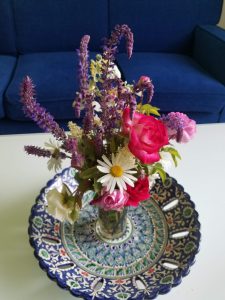1 Creating Inviting Spaces for Learning

One overlooked aspect of group facilitation is the importance of creating welcoming environments. I like the concept of “hosting” learning events. When we invite people for dinner, we often tidy up and set the table to create a warm, relaxing atmosphere. Colour, beauty and music can uplift the energy of the room and this attention to detail lets participants know that they are embarking on a special kind of learning. It does not need to be fancy, but small shifts with softer lighting, music and a piece of colorful cloth, sends a message that you care about the quality of the interactions and learning that will happen.
Case Study for creating a hospitable learning environment
“Living Life on Purpose” 8-week Workshop Series, Salmo Community Services
My friend and colleague, Leslie Comrie, and I designed a series of workshops for women called “Living Life on Purpose.” Most of the participants were on our counselling case loads and had experienced domestic violence and/or mental health issues. Our goal was to provide a safe group experience where the women could explore wellbeing strategies and support each other as they integrated new beliefs and habits into their daily lives.
Like all co-facilitators, we had different strengths and styles and we found ways to complement each other. We thrived on the process of designing sessions, sharing leadership and celebrating our participants’ growth.
One of the most important things I learned from Leslie was what she calls “setting the heaven.” This was a process of fully preparing the workshop room in a way that allowed people to experience a sense of both heightened awareness and deep relaxation.
Here are the elements we would use for each session to create a beautiful, safe and welcoming space:
- We would arrive in the workshop room an hour ahead of participants
- Chairs and/or tables were organized in either a horseshoe or circle where people could all see each other
- Resources, hand-outs, art supplies were organized on a side table and if needed and the IT was tested and ready to use
- We would usually bring a table cloth and flowers and put them either in the middle of the circle or at the front of the room. This small gesture creates a sense of beauty and sends the message that this will be a special experience.
- We would finish setting up the room 15 minutes before participants arrived and take a few moments for us to connect, breathe and calm our nervous systems so that we could fully engage with the needs of our learners.
- When participants started arriving, we took time to meet each person and greet them by name as they settled into the circle.
- Once the group was assembled, we would ask one of the participants to ring the chimes and we would guide a mindful moment to start our process together.
This menu of elements can be changed to suit the culture and needs of participants. In many indigenous communities, smudging the space with sage and juniper is a way of cleansing and preparing the atmosphere. In North America there is also usually an acknowledgement offered to the original indigeneous people who lived on the colonized land where the learning is taking place.
It is also worthwhile to consult with participants about what a welcoming environment looks and feels like for them. Some North American counselling and social work offices recognized that their waiting room and office environments were more appealing to women than male or nonbinary clients. Effort was made to include diverse clients in a conversation about the art, magazines and furnishings that created a sense of comfort and inclusion for all orientations and cultures.
When people are being invited to learn about themselves as social and emotional beings, they need a safe container. A calm environment sets the tone for an intentional community that is ready to listen and learn from one another.

